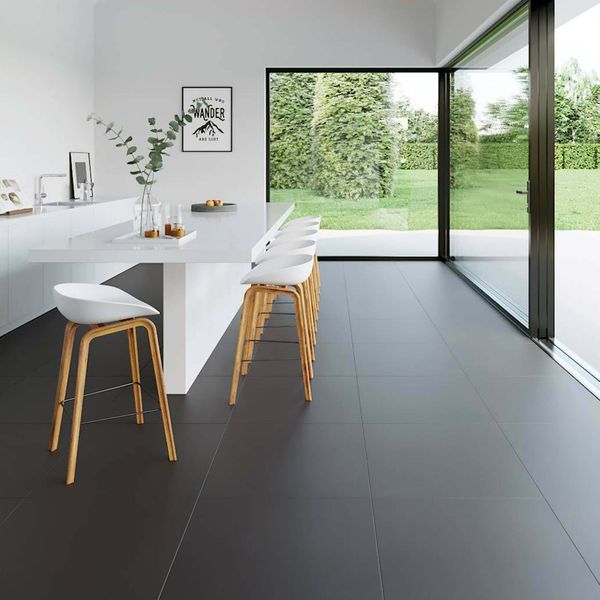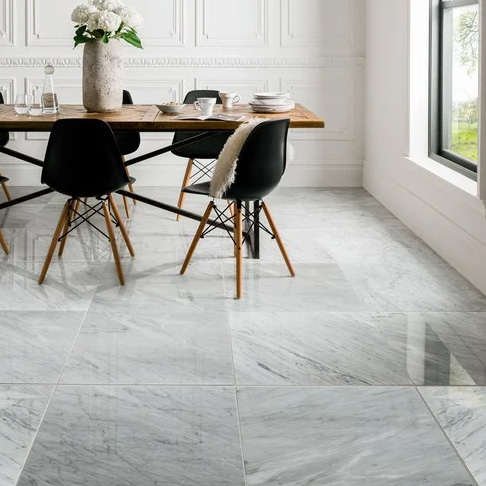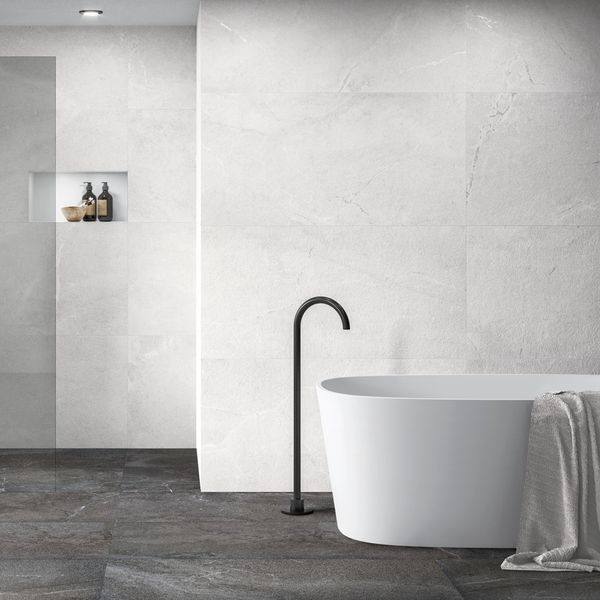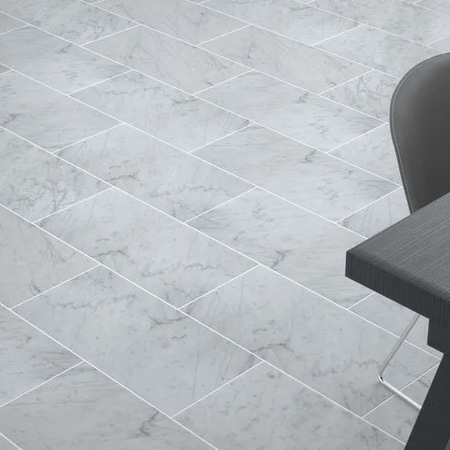Thanks to ever popular DIY shows and COVID, the construction and home improvement industry has been booming. In the last few years, more and more courses to learn how to tile have launched. This is because, of all the home improvement projects, bathroom and kitchen floor renovations are the most popular. For many people, the kitchen is an integral part of their home. Not only is it the place where families cook and spend time together, but it’s also the heart of the home. That’s why we’ve created this guide to go over everything you need to know about choosing the best tile for kitchen floor.


WHAT YOU NEED TO KNOW ABOUT TILE FOR KITCHEN FLOORS
Most home improvement projects involve the kitchen, but there are a few more things to keep in mind when undertaking a project like this.
The first is that kitchen renovations are not cheap. On a budget, they can cost around £11,500. But, for a full bespoke renovation the average cost is £35,000. The difference between these two average costs will come down to materials and workmanship.
Most people want granite, quartz, or marble for their countertops. Then there are the cabinets, which need to withstand regular use and hold the weight of plates, glasses, and everything else you store in them.
Then, there’s the flooring. The kitchen floor is a high-traffic area so you want heavy-duty material that can handle it.
In the early 20th century, linoleum (or lino) became trendy as kitchen flooring. This trend continued well into the 90’s, becoming a popular budget option. People still use it today, but you’ll see less of it. That’s because technology and trends have evolved.
Logistics make imported materials easier to get a hold of, which leads to what seems like thousands of flooring choices. But don’t worry! We’re going to help you navigate through your options, so you can pick the best tile for your kitchen floor.
PICKING THE BEST TILE FOR YOUR KITCHEN FLOOR
Here are some things to consider before we get into all your options:
DURABILITY
As mentioned, your kitchen is a high-traffic area, so you need durable flooring. This means that you should avoid choosing cheap stick-on tile to save money. It’s popular, but it isn’t the best tile for kitchen floor. The corners will come up, they tear, and the adhesive may give out. You’ll know a tile’s durability by its PEI rating. This is a system that tells you, in essence, where the best place to install a certain tile is.
- PEI 0 – Absolutely no foot traffic; These tiles are not suitable for floors
- PEI 1 – No foot traffic, or soft footwear worn; in general, refers to most wall tiles
- PEI 2 – Light foot traffic; includes wall tiles and flooring in guest bathrooms
- PEI 3 – Light to moderate use; includes wall tiles, most flooring, and countertops
- PEI 4 – Moderate to heavy use; residential and industrial flooring
- PEI 5 – Heavy to extra-heavy use; not typically found in residential applications, but used for commercial and industrial flooring
Check out Tile Mountain’s handy guide to understanding PEI ratings to get more information.
Not all manufacturers list the PEI rating for their tiles. However, most will at least give you a recommendation for the location where you should install it.
BEST TILE SIZE FOR KITCHEN FLOORS

Tiles come in a variety of sizes. You may love the look of a 60x60cm tile but if you have a smaller kitchen, using it may not fit well or look well-proportioned. Smaller, decorative tile may accent your countertops and complement your aesthetic, but may not give you the durability you need. They also may not be cost-effective.
It’s very common for people to use 30×30 tiles for a kitchen floor. However, you must make sure you have exact measurements. Measuring incorrectly and not ordering enough tile are two of the biggest mistakes in flooring projects.
You can avoid a lot of headaches by hiring a flooring contractor, but if you’re going 100% DIY, be sure to measure the area more than once. Additionally, make sure you buy enough tile for the project. Flooring stores and even big-box retailers do sell out of products. This means, just because there were dozens of cases available on Friday doesn’t mean they’ll be there Monday. Keep this in mind when selecting your best tile for kitchen floor.
COLOUR
When it comes to colour, you have a lot of options. This comes down to what you like and what will match the rest of your kitchen. Keep in mind that, while darker colours may “hide” more, they can make your kitchen appear smaller. Lighter hues will brighten your space and make it bigger but won’t hide much.
TEXTURE
Texture and safety go hand in hand. Textured and matte tiles are less slippery than glass or smooth tiles. Your kitchen floor will get wet at times, and even slippery from spills. Keep this in mind when selecting the best tile for your kitchen floor.
COST CONSIDERATIONS
When selecting tiles for your kitchen floor, it’s important to consider the costs. Prices can vary significantly depending on the type of tile, with natural stone and high-quality porcelain being more expensive than ceramic options. Additionally, the cost of installation can add a substantial amount to your budget, particularly if you require professional services. Sourcing tiles locally can help reduce costs and support local businesses, while also potentially providing access to bespoke designs and faster delivery times. Always compare prices from multiple suppliers and consider long-term value over initial expenditure.
INSTALLATION
If you’re a first-timer, prepping and installing tiles is a challenge, but it’s not impossible. Just make sure you follow the manufacturer’s suggestions. You also need to use the right tile cutter. Many equipment places rent them out but you can actually buy a wet table saw for less than you think.
Don’t forget your installation job needs more than just tiles and a saw. You also need tile spacers, a level, a trowel, and a grout float.

BEST TILE FOR KITCHEN FLOOR MAINTENANCE
No one wants to spend their weekends on their hands and knees cleaning tiles. Nevertheless, proper maintenance ensures that you’ll getting the longest life possible out of your flooring. Let’s look at how to maintain different types of tiles.
WOOD
Hardwood flooring is as popular as ever. If you live in an older home, you probably have it throughout your house, including in the kitchen. But, natural hardwood is high-maintenance. You need to re-seal it every so often and it can get scratched.
Laminate is more durable, though may not match your existing hardwood flooring. Wood look tile is a popular alternative that’s made of porcelain but with a finish that resembles wood. These can be tricky to install, so be sure to read up on all the unique challenges you’ll face.
PORCELAIN TILES
Porcelain and ceramic tiles are often confused. They look alike and share the same colours and sizes. But, believe it or not, there are differences between them.

Porcelain has added sand to its clay mixture. It’s made with heat and pressure, so the result is a harder, denser material. It’s also less porous. Because of their durability, porcelain tiles are also installed outside in patios, porches, or verandas. They withstand any climate, so they’re very versatile. The colouring is added to the clay, creating a richer colour that won’t fade as easily as other types.
Glazed porcelain is different. During the firing process, the material gets glazed to give it a glass-like effect. The colour is added during the glazing process, so it may appear uneven. It also scratches easier than non-glazed and is more slippery than non-porous porcelain.
Installing porcelain tile requires special tools and patience. If you’re going it alone, make sure you follow the manufacturer’s recommendations. Our DC and DCX tile saws work well for both ceramic and porcelain, but its ability to cut the latter is where they shine brightest.
CERAMIC TILES
Ceramic tiles are softer and more porous than porcelain. This material also goes through a glazing process to create a harder surface. These tiles are available in any colour you can think of and in many different textures. While they are softer, the glazing gives them a surface that is very easy to clean. They’re low maintenance and durable, which is why they’re a favourite among tilers and homeowners alike.
Installing ceramic tiles is easier than working with porcelain, though installing any tile is difficult if you’ve never done it before. Even if you have, one misstep can throw off the whole project. Taking your time during the prep work will make the job smoother.
STONE TILES
Natural stone tiles are exactly what they sound like. They’re made from stone, not clay or sand. The most popular stone tiles are:
- Slate
- Granite
- Limestone
- Travertine
- Marble
Because these are natural substances, you’ll need to re-seal them every two to three years. There are many types of natural stone finishes, however the two most popular ones are polished and honed. Polished stone, like marble, is slippery. Sometimes it doesn’t even have to be wet to cause someone to slip or fall. However, polished stone is gorgeous and the natural beauty of the material can shine through.
In general, honed stone has a rougher texture. It also has a duller colour. However, the rougher texture does provide anti slip properties, and sometimes a duller colour tile works best to allow other aspects of the renovation to shine.

The most common natural stone you’ll find in a honed texture is travertine or granite. You can also find limestone and other natural stone tiles in many textures and finishes.
Natural stone tiles generally come in larger sizes and are more expensive than porcelain or ceramic tile. They also requires different saws and cutters than ceramic and porcelain. Commonly, natural stone flooring is made by selecting a few slabs of natural stone and then cutting it down into the appropriate sizes for the project. You can, however, find smaller natural stone tiles in some stores.
When it comes to cutting natural stone our DCX or DX 350 is the best tool for the job.
LET’S BUILD TOGETHER
Tiling or re-tiling your kitchen is the quickest way to give it a fresh look. Just make sure you’re choosing the best tile for your kitchen floor. Decorative tile or glass-like textures can look beautiful, but they are slippery and may not hold up as well as you need them to. Stone tiles are rugged and durable, but they are also high-maintenance. Ceramic and porcelain are classic choices, with the most options in colours, textures, and sizes.
Visit our website to see everything we have to offer to help you carry out your project with confidence. Don’t forget, your tile cutter won’t run as efficiently as it should without a good blade or maintenance. Check out our video for maintaining your manual and electric cutters.



Post a comment